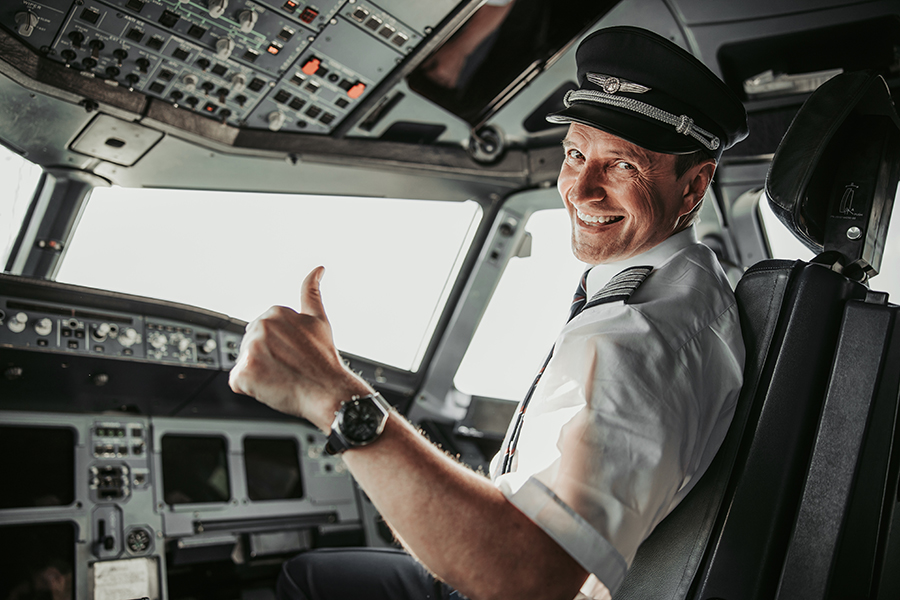-
Key Takeaways
-
What Is Mach Number?
- The Speed of Sound in Aviation
-
Why Mach Number Is Important for Pilots
- Limitations of Indicated Airspeed at High Altitudes
- Managing Compressibility Effects
-
Flight Regimes Defined by Mach Number
- Subsonic Flight
- Transonic Flight
- Supersonic Flight
- Hypersonic Flight
-
Effects of Mach Number on Aircraft Performance
- Critical Mach Number
- Compressibility and Shock Waves
- Mach Tuck and Control Issues
-
How Pilots Use Mach Number in Flight Operations
- Flight Planning and Mach Techniques
- Monitoring Mach Number in the Cockpit
- Observing Mach Limits (MMO)
-
Instrumentation and Measuring Mach Number
- Machmeter Functionality
- Temperature and Pressure Effects
-
Real-World Applications and Examples
- Commercial Aviation
- Supersonic and Hypersonic Travel
- High-Altitude Flight Operations
-
Conclusion
Why do jet pilots talk about speed in terms of Mach number? Why don’t they use Indicated Airspeed just like the pilots who fly slower aircraft?
Jet aircraft often fly at speeds close to the speed of sound.
Flight at those speeds introduces all kinds of challenges, including the need to know your speed in relation to the speed of sound. Here’s why.
Key Takeaways
- Mach number is a dimensionless ratio of true airspeed to local speed of sound. It varies with temperature.
- Pilots switch to Mach number at high altitudes to avoid inaccuracies in IAS due to compressibility effects.
- Critical Mach number is where airflow first hits Mach 1. This triggers issues like Mach tuck and shockwaves.
- Aircraft cruising speeds are chosen close to, but below, critical Mach for efficiency and safety.
What Is Mach Number?
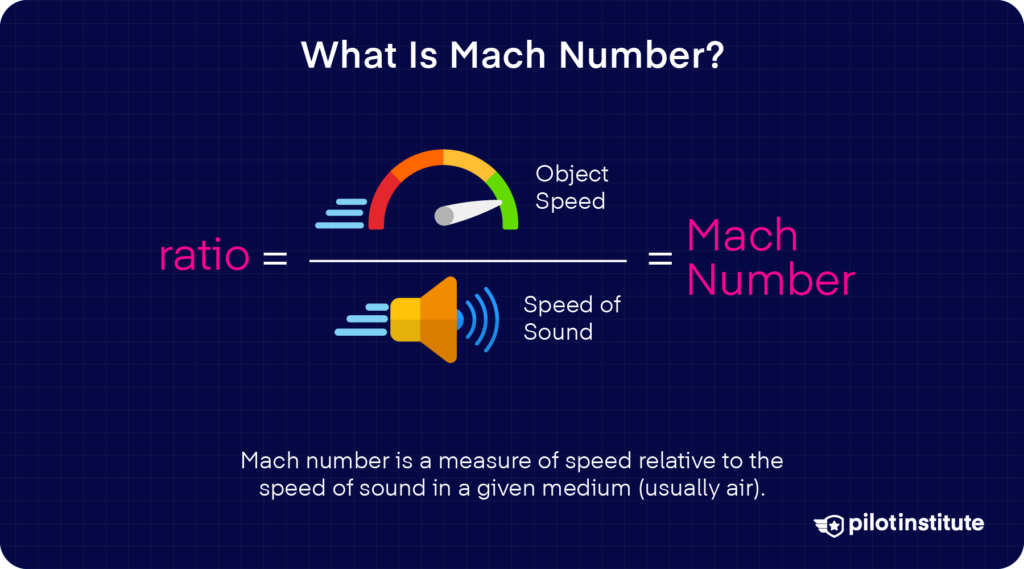
Mach number is simply a ratio of your true airspeed to the local speed of sound.
In terms of a formula, you can write it as:
Mach number (M)= True Airspeed (TAS) / Speed of Sound (a)
This means Mach 1 is the speed of sound, Mach 0.5 is half the speed of sound, Mach 2 is twice the speed of sound, and so on.
It’s clear to see from the formula that Mach number is nothing more than a simple ratio or a comparison. Since it’s a ratio, it doesn’t matter if you measure speed in knots, miles per hour, or meters per second. The Mach value stays the same. We can say the Mach number is dimensionless.
Why is it called the Mach number? The term “Mach” is named in honor of 19th-century physicist Ernst Mach, one of the first scientists to deeply study the physics of objects moving through the air faster than sound.
The Speed of Sound in Aviation
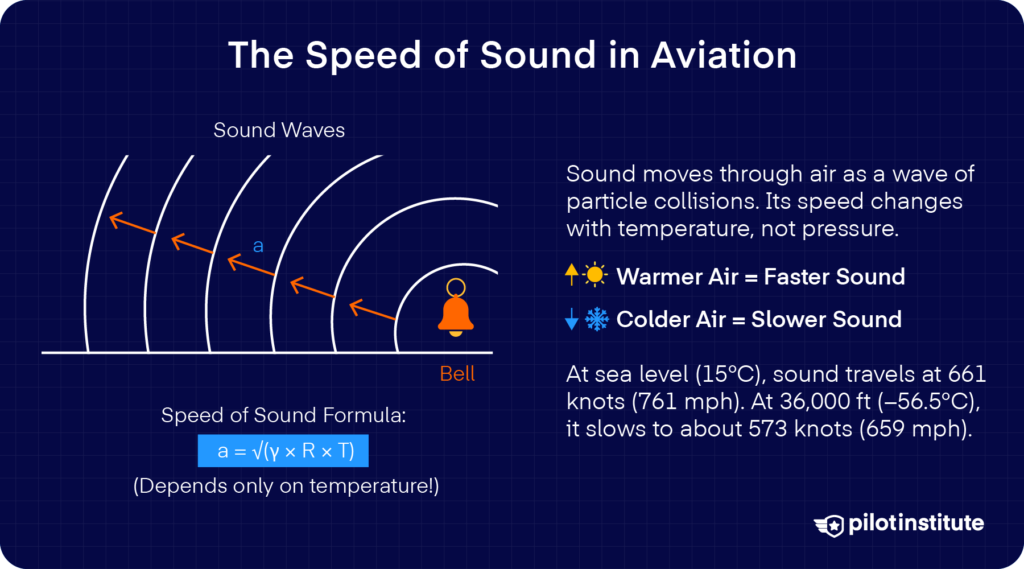
Air is made up of a collection of particles moving around and bumping into each other. Sound moves as a wave of these collisions through the air.
The speed of this wave, and therefore sound, is not constant. It varies mainly with air temperature since colder air means slower-moving air molecules, dropping the speed of sound.
At sea level on a standard day (15 °C or 59 °F), sound travels about 661 knots (approximately 761 mph or 1,225 km/h).
As you go higher, the air usually gets colder. When you reach around 36,000 feet (11,000 m) near the tropopause, the temperature stabilizes at around -56.5 °C. Here, Mach 1 is roughly 573 knots (about 659 mph).
There’s a common misconception here that you must be careful about. The speed of sound depends on temperature, not on air pressure.
The formula for the speed of sound is:
a = √(γ × R × T)
In this formula,
- γ (gamma) is the ratio of specific heats for air (approximately 1.4 for dry air).
- R is the gas constant.
- T is the absolute temperature (in Kelvin).
As you can see, the equation doesn’t involve pressure at all, just temperature.
Why Mach Number Is Important for Pilots
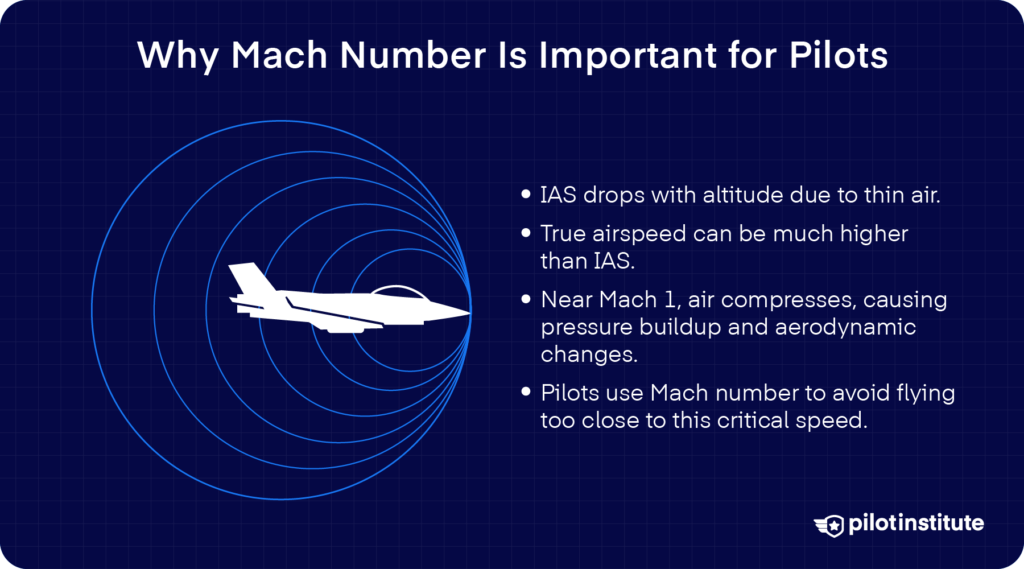
Limitations of Indicated Airspeed at High Altitudes
If you’ve flown light aircraft at lower altitudes, you’re used to thinking in terms of indicated airspeed (IAS). That’s the speed your airspeed indicator shows based on ram air pressure in the pitot tube.
Indicated airspeed works reasonably well to estimate how the aircraft “feels” the air. Lift, drag, and handling correlate well with IAS in the lower atmosphere.
But as your aircraft climbs higher into the atmosphere, you’ll find the air getting thinner and thinner. Air density drops with altitude, so for a given true speed, dynamic pressure (and thus IAS) will be lower at high altitudes.
For example, an airliner might indicate only 250 knots at 35,000 feet, but its true airspeed could be over 430 knots. The danger is that IAS alone doesn’t warn you that you’re nearing Mach 1 in these conditions, because IAS is “fooled” by the low density.
This is why pilots flying at high altitudes switch to Mach number as their speed reference instead of IAS. They don’t want to get too close to Mach 1 accidentally.
And why should pilots be wary of Mach 1? To find out the answer, you need to know about compressibility.
Managing Compressibility Effects
At low speeds, air can be considered incompressible. It easily gets out of the way of your aircraft without big changes in density or pressure.
But as you start getting close to Mach 1, the air in front of the aircraft can’t move aside fast enough. The molecules bunch together and build up pressure.
This leads to a host of new aerodynamic effects that pilots of fast aircraft must manage.
Flight Regimes Defined by Mach Number
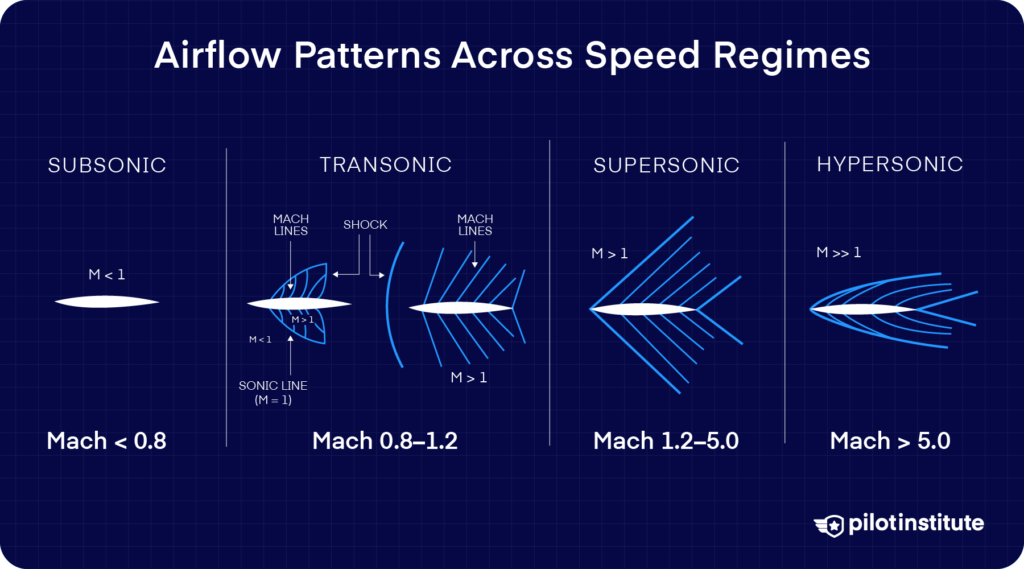
Subsonic Flight
Subsonic speeds refer to flight at Mach numbers below about 0.8. The airflow around the aircraft is entirely below Mach 1, so no shock waves form anywhere on the aircraft.
Compressibility effects are small enough to be ignored entirely in the lower end of the subsonic range.
In this regime, we can use the “usual” aerodynamics taught in basic flight training, such as Bernoulli’s principle, without too much error.
Aircraft designed for subsonic flight tend to have rounded noses and unswept or moderately swept wings. There’s no need for sharp noses or steep wing sweeps because we don’t need to try to delay shock formation. We’re avoiding shockwaves by staying slow.
Transonic Flight
Transonic flight is the critical space roughly between Mach 0.8 and 1.2. This is where the flow around the aircraft is part subsonic and part supersonic, often simultaneously.
The transonic regime includes the speed range where shock waves first appear and strengthen on the aircraft.
Aircraft designed for transonic flight have built-in features to deal with shock waves. Swept wings effectively reduce the airflow component they receive, allowing the aircraft to fly faster before airflow over them exceeds Mach 1.
Even the wing cross-section can be designed to redirect shock waves. Making the wing relatively flat on top with a blunter leading edge and more curvature on the bottom gives you a supercritical airfoil. This type of wing redirects the shockwaves further aft on the wing, reducing drag.
Supersonic Flight
Supersonic speeds are those above Mach 1.2 (roughly) up to about Mach 5.0. Once an aircraft is flying truly faster than the speed of sound, the airflow patterns change drastically.
In supersonic flight, a bow shock wave forms at the nose and leading edges of the aircraft. This is the main shockwave the aircraft experiences. You’ll get additional shock waves at any part of the aircraft that has an abrupt change in shape. This could be inlets or wing leading edges if they’re not sharp enough.
All the airflow around the aircraft moves through shock waves because the aircraft is outrunning its pressure disturbances.
Air experiences a drastic pressure, temperature, and density jump as it passes through a shock wave. This effect is responsible for the most famous phenomenon associated with supersonic flight, the sonic boom.
The sonic boom isn’t just a one-time event. As long as the aircraft is supersonic, it continuously generates shock waves that emanate outward and down.
Hypersonic Flight
When anything flies faster than Mach 5.0, we call it travelling at hypersonic speed. Only experimental vehicles, spacecraft, and the fastest military projects have flown this fast.
At hypersonic speeds, the compression of air ahead of the vehicle generates enormous temperatures. The airframe sees temperatures that can melt conventional materials. That’s why thermal protection becomes necessary. Aircraft manufacturers do that in the form of special heat-resistant tiles, ablative shields, and advanced materials like refractory metals or ceramics.
In fact, air can get so hot that oxygen can dissociate (break apart) or even chemically react with the vehicle surface or other gases.
Hypersonic aircraft designs often have to balance being blunt enough not to overheat, yet aerodynamic enough to maintain control.
Effects of Mach Number on Aircraft Performance
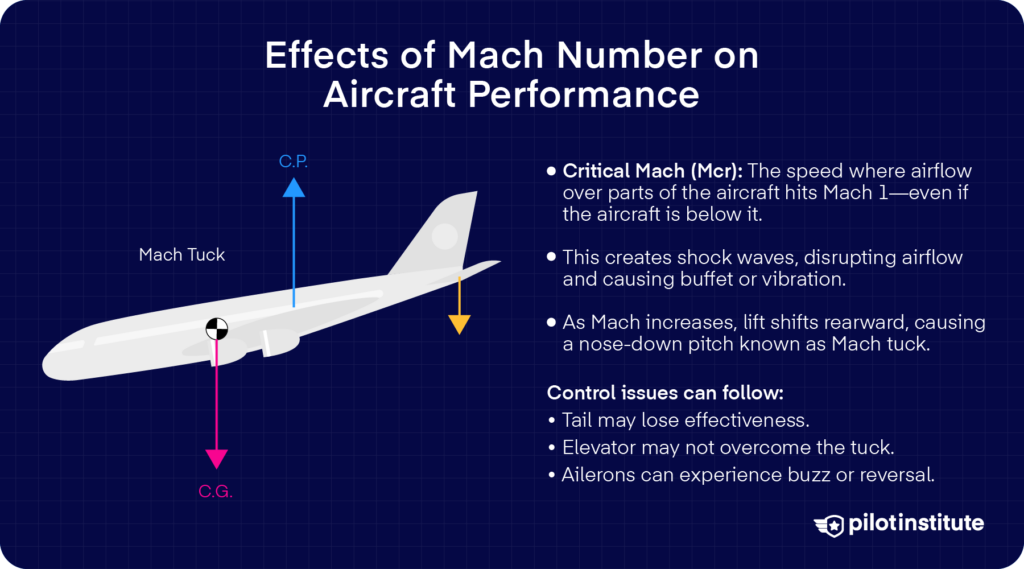
Critical Mach Number
Why do aircraft experience adverse effects from the speed of sound before reaching Mach 1?
For most aircraft with highly cambered wings or thick profiles, airflow accelerates over the top of the wing. So you might be flying at, say, Mach 0.85 in free air, but the airflow speeding over the wing’s curvature may hit Mach 1 in some parts.
The lowest Mach number at which some part of the airflow over the aircraft first reaches the speed of sound is called the Critical Mach number (Mcr).
Compressibility and Shock Waves
When you reach Mcr, a small shock wave forms at any spot on the aircraft where the local airflow hits Mach 1.
The shock wave disrupts the smooth airflow, causing it to separate from the wing in places. The result is a region of separated, turbulent flow behind the shock. This can make the aircraft shake or buffet, similar to the buffeting near a stall.
Mach Tuck and Control Issues
Early in transonic flight, shock-induced separation on the wing often starts near the wing root and moves outward.
This means the inboard wing loses lift first, while the wingtips might still be lifting. The net lift vector moves rearward as Mach increases into the transonic range. This rearward shift produces a nose-down moment since the lift is now acting behind where it used to.
This nose-down pitching moment is called Mach tuck.
If left unchecked, the nose-down attitude causes the aircraft to descend and accelerate. As it accelerates, the Mach number increases further, which can make the shock and separation even worse, increasing the nose-down moment even more.
The pilot will attempt to counter this by pulling back on the elevator. The problem is that the tail itself might be in trouble.
The tailplane (horizontal stabilizer) at high Mach can also develop shocks or experience disturbed airflow from the wings. Its effectiveness at providing a nose-up force reduces at the exact moment you need it most.
In extreme cases, the elevator may not have enough authority to overcome the tuck. Early jet pilots found this out while exploring high-speed jet flight. They couldn’t pull out because the tail wasn’t generating enough force in the high Mach regime.
It’s not just the tail that experiences control issues. Ailerons can suffer from a phenomenon called “aileron buzz” or control reversal at high Mach.
How Pilots Use Mach Number in Flight Operations
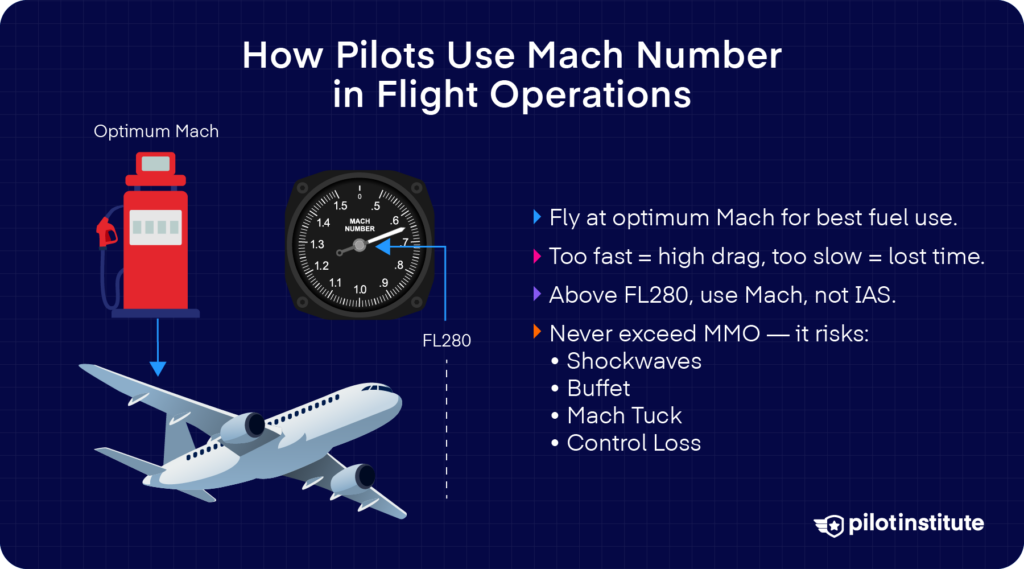
Flight Planning and Mach Techniques
Every aircraft has an optimum cruise speed that gives it the best fuel mileage.
Flying much faster than that optimum burns disproportionately more fuel for a minor gain in time. This is partly due to the steep rise in drag nearing Mcr.
Safety is also a factor. Commercial airliners aren’t designed for supersonic flight. It’s unsafe to risk control issues and stress on the airframe structure by flying too close to Mach 1.
On the other hand, flying much slower might save fuel per mile, but then you spend more time in the air. This could incur other costs and reduce the number of flights you can fly daily.
Monitoring Mach Number in the Cockpit
Since IAS fails to accurately estimate speed at high altitudes, pilots switch to the Mach scale to manage their speed once they’re in a high-altitude cruise.
Typically, jets climb at a constant IAS until around flight level 280, then transition to constant Mach. Pilots reverse this routine when it’s time to descend.
Observing Mach Limits (MMO)
Every aircraft certified for high-speed flight has a published Maximum Mach Operating speed. This is the red line Mach number that pilots must not exceed in normal operations.
Why is exceeding MMO dangerous?
Flying above MMO will trigger an overspeed alarm. Flying faster is unsafe because the aircraft isn’t designed to cope with the stress from the shockwaves.
Factors like Mach tuck, the buffet, and unresponsive controls can also lead to an uncontrollable aircraft.
Instrumentation and Measuring Mach Number
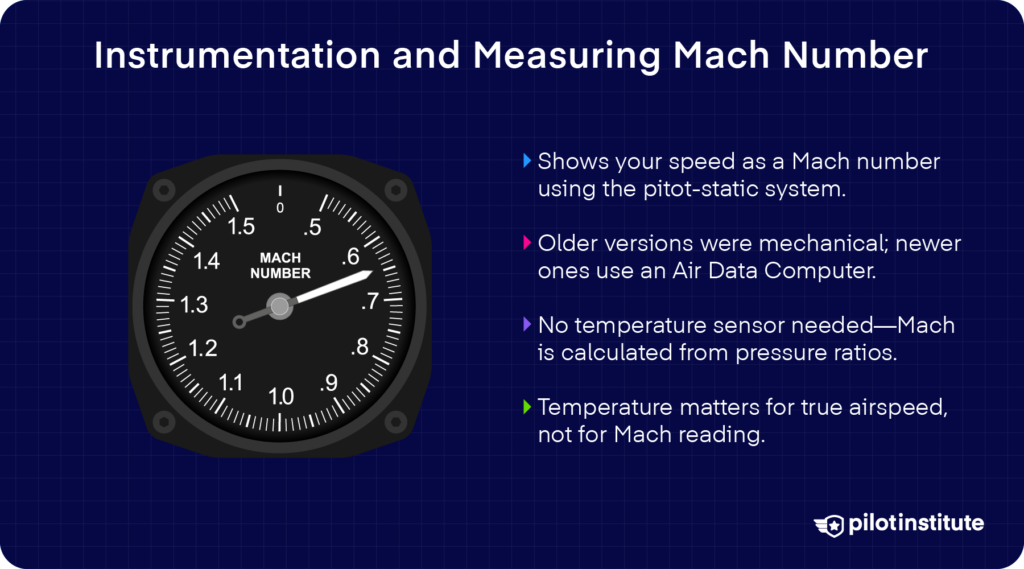
Machmeter Functionality
The instrument in the cockpit that gives your speed on the Mach scale is called a Machmeter.
This instrument uses the pitot-static system and compares dynamic pressure with static pressure and an altitude input to drive a Mach scale.
Older Machmeters were purely mechanical. Newer ones use the Air Data Computer to calculate Mach for you.
Temperature and Pressure Effects
Even though Mach is defined as your true speed divided by the speed of sound (which depends on temperature), the Machmeter itself doesn’t need a temperature sensor.
It just uses the ratio of total and static air pressures to figure out Mach directly, because that ratio tells you how fast you’re going compared to the speed of sound in the current conditions.
Because of this, the Mach reading itself doesn’t actually need outside air temperature. Temperature only matters when you want to figure out your true airspeed, since the speed of sound depends on temperature.
That’s why modern air data systems have temperature sensors. They help show accurate true airspeed but don’t change the Mach reading.
Real-World Applications and Examples
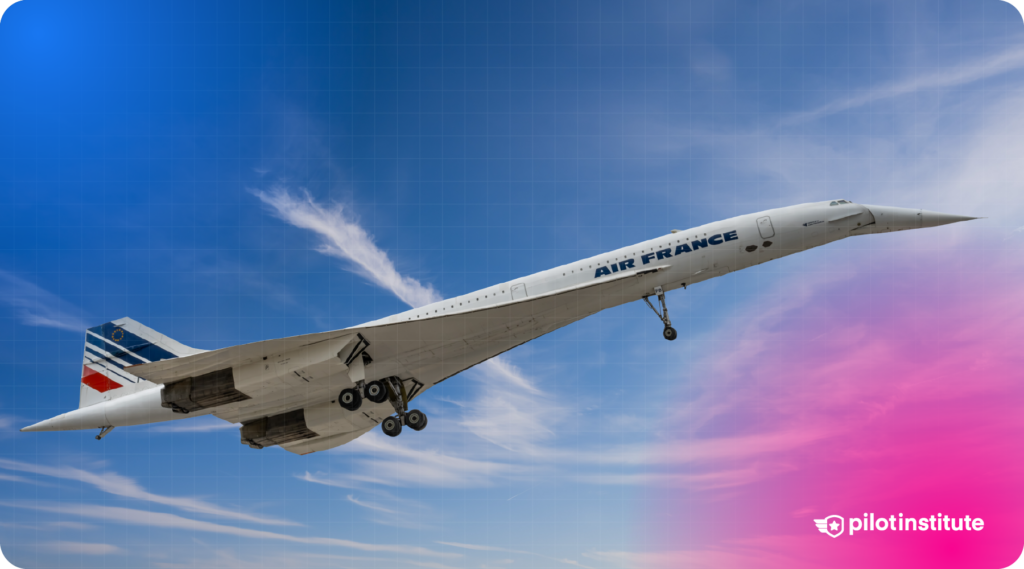
Commercial Aviation
Modern airliners typically cruise at high subsonic Mach numbers, usually around Mach 0.78 to 0.85, depending on the aircraft model and the airline’s preferences.
For example, the Airbus A320 family of airliners often cruises about Mach 0.78–0.79. A Boeing 777 or 787 flies at around Mach 0.84–0.85. Smaller regional jets cruise at Mach 0.74–0.78.
All these cruise speeds are chosen to be just under the aircraft’s Mcr for efficiency while leaving some margin for safety.
Mach won’t change with wind, but if you have a strong tailwind, you might accept a slightly lower Mach because the tailwind already boosts ground speed significantly.
For example, flights from Europe to the US often encounter headwinds from the jet stream. They might plan Mach 0.82 westbound, but can do Mach 0.78 eastbound when tailwinds push them. This helps them save fuel on the eastbound leg.
Supersonic and Hypersonic Travel
The Anglo-French Concorde remains the icon of civil supersonic flight. It routinely cruised at about Mach 2.02 to 2.04. Its Soviet counterpart, the Tupolev Tu-144, was actually the world’s first commercial supersonic transport aircraft, beating the Concorde to supersonic flight by a few months.
Concorde flew for 27 years of regular service. Its supersonic cruise speed shortened the flight time from New York to London from 8 to around 3 hours.
Military supersonic flight is common: fighters like the F-15, F-16, and F/A-18 can exceed Mach 2 but only in short bursts due to extremely high fuel consumption.
The F-22 Raptor introduced the idea of supercruise. This means flying supersonic without using afterburner. It can supercruise above Mach 1.5 on dry thrust alone. This avoids the huge fuel penalty from afterburner and allows it to stay supersonic longer.
[Post Banner: Private Pilot Made Easy]
Why do military aircraft fly supersonic?
Military tactics and strategy involve energy management. The ability to fly faster than Mach 1 can allow them to reposition themselves rapidly to gain a strategic advantage.
The SR-71 Blackbird was a Cold War spy aircraft that cruised at Mach 3.2 at very high altitudes to protect itself from being targeted by missiles.
High-Altitude Flight Operations
At very high altitudes, you come close to an aircraft’s maximum altitude capability. At these heights, you have two limiting speeds:
- Stall limit: Even at cruise, an aircraft must maintain a minimum airspeed to produce enough lift for the thin air at altitude.
You will experience buffeting when you get close to the stall limit, although here the buffet comes from a high angle of attack. - Mach limit: This is the high-speed Mcr we’ve discussed. Exceed it and you get shock waves, Mach buffet, Mach tuck, and control problems.
As you go higher, the space between these two speeds reduces. This is the coffin corner, named grimly because straying above or below that tiny speed window could be disastrous.
What happens if an aircraft in coffin corner hits turbulence?
If it jolts upward, momentarily increasing your angle of attack, you might hit the stall buffet.
Or if it jolts downward or gains speed, you might overshoot the Mach limit.
This is why high-altitude operations need great care from the pilots.
Conclusion
Your average Cessna pilot does not have to worry about things like compressibility and Mach buffeting.
However, dealing with Mach effects is one of the biggest adjustments pilots make when moving from slow-speed aircraft to high-speed jets.
For aviation enthusiasts, knowing why pilots use Mach numbers is a good introduction to lesser-known concepts about aerodynamics and high-speed flight.



